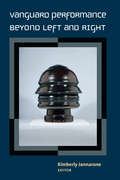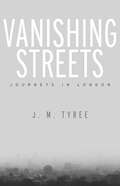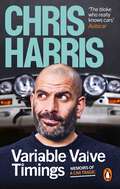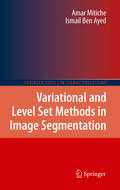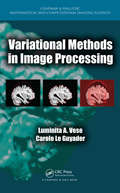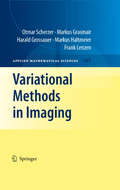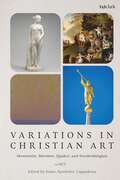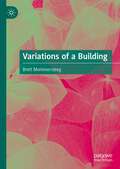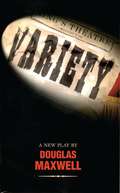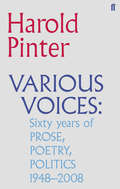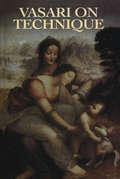- Table View
- List View
Vanessa Bell: Portrait of the Bloomsbury Artist
by Frances SpaldingEven through the lens of the twenty-first century, the story of Vanessa Bell's life is unorthodox. A powerful magnetic figure, Bell lived at the heart of the Bloomsbury Group and was often the core figure around which the disparate individuals of the movement revolved. Her art and designs – so often overshadowed by her sister Virginia Woolf's writings and fame and by the interest in her own unconventional life – made a significant contribution to the history of the Bloomsbury Group. Yet, until this authorised biography was written, she has remained a largely silent and enigmatic figure. In this captivating account, acclaimed art historian and biographer, Frances Spalding, restores Bell to the heart of the Bloomsbury Group, illuminating an exceptional life and the free-spirited circle among which she lived.
Vanguard Performance Beyond Left and Right
by Kimberly JannaroneVanguard Performance Beyond Left and Right challenges assumptions regarding “radical” and “experimental” performance that have long dominated thinking about the avant-garde. The book brings to light vanguard performances rarely discussed: those that support totalitarian regimes, promote conservative values, or have been effectively snapped up by right-wing regimes the performances intended to oppose. In so doing, the volume explores a central paradox: how innovative performances that challenge oppressive power structures can also be deployed in deliberate, passionate support of oppressive power. Essays by leading international scholars pose engaging questions about the historical avant-garde, vanguard acts, and the complex role of artistic innovation and live performance in global politics. Focusing on performances that work against progressive and democratic ideas (including scripted drama, staged suicide, choral dance, terrorism, rallies, and espionage), the book demonstrates how many compelling performance ideals—unification, exaltation, immersion—are, in themselves, neither moral nor immoral; they are only emotional and aesthetic urges that can be powerfully channeled into a variety of social and political outlets.
Vanguardia: Socially engaged art and theory
by Marc James LégerThe avant garde is dead, or so the story goes for many leftists and capitalists alike. But in an era of neoliberal austerity, neocolonial militarism and ecological crisis, this postmodern view seems increasingly outmoded. Rejecting ‘end of ideology’ post-politics, Vanguardia delves into the changing praxis of socially engaged art and theory in the age of the Capitalocene. Covering the major events of the last decade, from anti-globalisation protests, Occupy Wall Street, the Maple Spring, Strike Debt and the Anthropocene, to the Black Lives Matter and MeToo campaigns, Vanguardia puts forward a radical leftist commitment to the revolutionary consciousness of avant-garde art and politics.
Vanguardia: Socially engaged art and theory
by Marc James LégerThe avant garde is dead, or so the story goes for many leftists and capitalists alike. But in an era of neoliberal austerity, neocolonial militarism and ecological crisis, this postmodern view seems increasingly outmoded. Rejecting ‘end of ideology’ post-politics, Vanguardia delves into the changing praxis of socially engaged art and theory in the age of the Capitalocene. Covering the major events of the last decade, from anti-globalisation protests, Occupy Wall Street, the Maple Spring, Strike Debt and the Anthropocene, to the Black Lives Matter and MeToo campaigns, Vanguardia puts forward a radical leftist commitment to the revolutionary consciousness of avant-garde art and politics.
Vanished Armies: A Record of Military Uniform Observed and Drawn in Various European Countries During the Years 1907 to 1914. (Shire General Ser. #1)
by Ae Haswell Miller John MolloIn the years immediately before the First World War, Archibald Haswell Miller, a young artist, travelled Europe to study painting. While he was there he indulged his other great interest the military. On his travels he observed first-hand the soldiers of the European Armies in the last days of the colourful and elaborate uniforms that were giving way to grey and khaki across the continent. Realising that this was a great military heritage that was slipping away he set out to record these splendid uniforms. In those uncertain days before the assassination of the Archduke Ferdinand in Sarajevo, Haswell Miller sketched and painted hundreds of figures, each wearing a different uniform, from the armies of Britain, Germany, France, Austria-Hungary, Belgium, Holland, Italy, Portugal, Russia, Spain and Sweden. Just before the First World War the paintings were exhibited in Leipzig, and it seemed they might be published. But when war broke out they were returned home and lay forgotten for nearly one hundred years. Now published together at last, they represent a unique record of the uniforms of the last great age of military dress. Accompanied by, in Haswell Miller's own words, 'notes and memories of the days before "the lights went out in Europe†? in the year 1914', this is a book of great historical importance.
Vanished Armies: A Record of Military Uniform Observed and Drawn in Various European Countries During the Years 1907 to 1914.
by Ae Haswell Miller John MolloIn the years immediately before the First World War, Archibald Haswell Miller, a young artist, travelled Europe to study painting. While he was there he indulged his other great interest the military. On his travels he observed first-hand the soldiers of the European Armies in the last days of the colourful and elaborate uniforms that were giving way to grey and khaki across the continent. Realising that this was a great military heritage that was slipping away he set out to record these splendid uniforms. In those uncertain days before the assassination of the Archduke Ferdinand in Sarajevo, Haswell Miller sketched and painted hundreds of figures, each wearing a different uniform, from the armies of Britain, Germany, France, Austria-Hungary, Belgium, Holland, Italy, Portugal, Russia, Spain and Sweden. Just before the First World War the paintings were exhibited in Leipzig, and it seemed they might be published. But when war broke out they were returned home and lay forgotten for nearly one hundred years. Now published together at last, they represent a unique record of the uniforms of the last great age of military dress. Accompanied by, in Haswell Miller's own words, 'notes and memories of the days before "the lights went out in Europe†? in the year 1914', this is a book of great historical importance.
The Vanished Collection: Stolen masterpieces, family secrets and one woman's quest for the truth
by Pauline Baer PerignonA charming and heartfelt story about war, art, and the lengths a woman will go to find the truth about her family. 'As devourable as a thriller... Incredibly moving' Elle 'Pauline Baer de Perignon is a natural storyteller – refreshingly honest, curious and open' Menachem Kaiser 'A terrific book' Le PointIt all started with a list of paintings. There, scribbled by a cousin she hadn't seen for years, were the names of the masters whose works once belonged to her great-grandfather, Jules Strauss: Renoir, Monet, Degas, Tiepolo and more. Pauline Baer de Perignon knew little to nothing about Strauss, or about his vanished, precious art collection.But the list drove her on a frenzied trail of research in the archives of the Louvre and the Dresden museums, through Gestapo records, and to consult with Nobel laureate Patrick Modiano. What happened in 1942? And what became of the collection after Nazis seized her great-grandparents' elegant Parisian apartment?The quest takes Pauline Baer de Perignon from the Occupation of France to the present day as she breaks the silence around the wrenching experiences her family never fully transmitted, and asks what art itself is capable of conveying over time.
The Vanishing Man: In Pursuit of Velazquez
by Laura CummingWINNER OF THE JAMES TAIT BLACK BIOGRAPHY PRIZESHORTLISTED FOR THE RATHBONES FOLIO PRIZELONGLISTED FOR THE BAILLIE GIFFORD PRIZE FOR NON-FICTIONSelected as a Book of the Year in the Herald In 1845, a Reading bookseller named John Snare came across the dirt-blackened portrait of a prince at a country house auction. Suspecting that it might be a long-lost Velázquez, he bought the picture and set out to discover its strange history - a quest that led from fame to ruin and exile.Fusing detection and biography, this book shows how and why great works of art can affect us, even to the point of mania. And on the trail of John Snare, Cumming makes a surprising discovery of her own. But most movingly, The Vanishing Man is an eloquent and passionate homage to the Spanish master Velázquez, bringing us closer to the creation and appreciation of his works than ever before.
Vanishing Streets: Journeys in London
by J. M. TyreeVanishing Streets reveals an American writer's twenty-year love affair with London. Beguiling and idiosyncratic, obsessive and wry, it offers an illustrated travelogue of the peripheries, retracing some of London's most curious locations. As J. M. Tyree wanders deliriously in "the world's most visited city," he rediscovers and reinvents places that have changed drastically since he was a student at Cambridge in the 1990s. Tyree stumbles into the ghosts of Alfred Hitchcock, Graham Greene, and the pioneers of the British Free Cinema Movement. He offers a new way of seeing familiar landmarks through the lens of film history, and reveals strange nooks and tiny oddities in out-of-the-way places, from a lost film by John Ford supposedly shot in Wapping to the beehives hidden in Tower Hamlets Cemetery, an area haunted by a translation error in W. G. Sebald's Austerlitz. This book blends deeply personal writing with a foreigner's observations on a world capital experiencing an unsettling moment of transition. Vanishing Streets builds into an astonishing and innovative multi-layered project combining autobiography, movie madness, and postcard-like annotations on the magical properties of a great city. Tyree argues passionately for London as a cinematic dream city of perpetual fascinations and eccentricities, bridging the past and the present as well as the real and the imaginary.
Variable-length Codes for Data Compression
by David SalomonMost data compression methods that are based on variable-length codes employ the Huffman or Golomb codes. However, there are a large number of less-known codes that have useful properties and these can be useful. This book brings this large set of codes to the attention of workers in the field and for students of computer science. The author’s crystal clear style of writing and presentation allows easy access to the topic.
Variable Valve Timings: Memoirs of a car tragic
by Chris HarrisTyre destruction, power slides and continuous droolingChris Harris has driven more cars than most people could ever dream of. His vast knowledge is legendary. He calls it 'unhinged geekery'. But we call it infectious enthusiasm, adrenaline-fueled escapism and peerless journalistic rigour and integrity.And then there are his famous skills at the wheel, from city cars to rally cars, F1 to vintage, not forgetting the Guinness World Record 3.4km sideways in an electric car.And now for the first time, Harris is going all out with that unhinged geekery, and takes us down the road of his life-long adventure with the automobile - from the Scalextric track to the Nürburgring 24 Hour, via his own formative low-powered Somerset version of The Dukes of Hazard.A highly individual, petrol-soaked life story that's all down to variable valve timings.
Variational and Level Set Methods in Image Segmentation (Springer Topics in Signal Processing #5)
by Amar Mitiche Ismail Ben AyedImage segmentation consists of dividing an image domain into disjoint regions according to a characterization of the image within or in-between the regions. Therefore, segmenting an image is to divide its domain into relevant components. The efficient solution of the key problems in image segmentation promises to enable a rich array of useful applications. The current major application areas include robotics, medical image analysis, remote sensing, scene understanding, and image database retrieval. The subject of this book is image segmentation by variational methods with a focus on formulations which use closed regular plane curves to define the segmentation regions and on a level set implementation of the corresponding active curve evolution algorithms. Each method is developed from an objective functional which embeds constraints on both the image domain partition of the segmentation and the image data within or in-between the partition regions. The necessary conditions to optimize the objective functional are then derived and solved numerically. The book covers, within the active curve and level set formalism, the basic two-region segmentation methods, multiregion extensions, region merging, image modeling, and motion based segmentation. To treat various important classes of images, modeling investigates several parametric distributions such as the Gaussian, Gamma, Weibull, and Wishart. It also investigates non-parametric models. In motion segmentation, both optical flow and the movement of real three-dimensional objects are studied.
Variational, Geometric, and Level Set Methods in Computer Vision: Third International Workshop, VLSM 2005, Beijing, China, October 16, 2005, Proceedings (Lecture Notes in Computer Science #3752)
by Nikos Paragios Olivier Faugeras Tony Chan Christoph SchnoerrMathematical methods has been a dominant research path in computational vision leading to a number of areas like ?ltering, segmentation, motion analysis and stereo reconstruction. Within such a branch visual perception tasks can either be addressed through the introduction of application-driven geometric ?ows or through the minimization of problem-driven cost functions where their lowest potential corresponds to image understanding. The 3rd IEEE Workshop on Variational, Geometric and Level Set Methods focused on these novel mathematical techniques and their applications to c- puter vision problems. To this end, from a substantial number of submissions, 30 high-quality papers were selected after a fully blind review process covering a large spectrum of computer-aided visual understanding of the environment. The papers are organized into four thematic areas: (i) Image Filtering and Reconstruction, (ii) Segmentation and Grouping, (iii) Registration and Motion Analysis and (iiii) 3D and Reconstruction. In the ?rst area solutions to image enhancement, inpainting and compression are presented, while more advanced applications like model-free and model-based segmentation are presented in the segmentation area. Registration of curves and images as well as multi-frame segmentation and tracking are part of the motion understanding track, while - troducing computationalprocessesinmanifolds,shapefromshading,calibration and stereo reconstruction are part of the 3D track. We hope that the material presented in the proceedings exceeds your exp- tations and will in?uence your research directions in the future. We would like to acknowledge the support of the Imaging and Visualization Department of Siemens Corporate Research for sponsoring the Best Student Paper Award.
Variational Methods in Image Processing (Chapman And Hall/crc Mathematical And Computational Imaging Sciences Ser.)
by Luminita A. VeseVariational Methods in Image Processing presents the principles, techniques, and applications of variational image processing. The text focuses on variational models, their corresponding Euler-Lagrange equations, and numerical implementations for image processing. It balances traditional computational models with more modern techniques that solve t
Variational Methods in Imaging (Applied Mathematical Sciences #167)
by Otmar Scherzer Markus Grasmair Harald Grossauer Markus Haltmeier Frank LenzenThis book is devoted to the study of variational methods in imaging. The presentation is mathematically rigorous and covers a detailed treatment of the approach from an inverse problems point of view. Many numerical examples accompany the theory throughout the text. It is geared towards graduate students and researchers in applied mathematics. Researchers in the area of imaging science will also find this book appealing. It can serve as a main text in courses in image processing or as a supplemental text for courses on regularization and inverse problems at the graduate level.
Variational Regularization of 3D Data: Experiments with MATLAB® (SpringerBriefs in Computer Science)
by Hebert Montegranario Jairo EspinosaVariational Regularization of 3D Data provides an introduction to variational methods for data modelling and its application in computer vision. In this book, the authors identify interpolation as an inverse problem that can be solved by Tikhonov regularization. The proposed solutions are generalizations of one-dimensional splines, applicable to n-dimensional data and the central idea is that these splines can be obtained by regularization theory using a trade-off between the fidelity of the data and smoothness properties.As a foundation, the authors present a comprehensive guide to the necessary fundamentals of functional analysis and variational calculus, as well as splines. The implementation and numerical experiments are illustrated using MATLAB®. The book also includes the necessary theoretical background for approximation methods and some details of the computer implementation of the algorithms. A working knowledge of multivariable calculus and basic vector and matrix methods should serve as an adequate prerequisite.
Variations in Christian Art: Mennonite, Mormon, Quaker, and Swedenborgian
by Diane Apostolos-CappadonaThe artistic traditions of four major Christian denominations are examined and outlined in detail in this groundbreaking volume that presents the first synthesis of the artistic contributions of those traditions. Diane Apostolos-Cappadona has curated a volume that presents four single-authored contributions in one place, broadening the study of Christian art beyond Roman Catholic, Orthodox and 'protestant' traditions to consider these more recent Christian approaches in close and expert detail. Rachel Epp Buller examines art in the Mennonite tradition, Mormon art is considered by Heather Belnap, Quaker contributions by Rowena Loverance and Swedenborgian art by Diane Apostolos-Cappadona. Each writer presents elements of the theology of their chosen tradition through the prism of the artists and artistic works that they have selected. Alongside mainstream artistic figures such as William Blake less known figures come to the fore and the volume features color illustrations that support and underline the theological and artistic themes presented in each section of the book. Together these studies of artistic presentations in these four traditions will be a much need means of filling a gap in the study of Christian art.
Variations in Christian Art: Mennonite, Mormon, Quaker, and Swedenborgian
The artistic traditions of four major Christian denominations are examined and outlined in detail in this groundbreaking volume that presents the first synthesis of the artistic contributions of those traditions. Diane Apostolos-Cappadona has curated a volume that presents four single-authored contributions in one place, broadening the study of Christian art beyond Roman Catholic, Orthodox and 'protestant' traditions to consider these more recent Christian approaches in close and expert detail. Rachel Epp Buller examines art in the Mennonite tradition, Mormon art is considered by Heather Belnap, Quaker contributions by Rowena Loverance and Swedenborgian art by Diane Apostolos-Cappadona. Each writer presents elements of the theology of their chosen tradition through the prism of the artists and artistic works that they have selected. Alongside mainstream artistic figures such as William Blake less known figures come to the fore and the volume features color illustrations that support and underline the theological and artistic themes presented in each section of the book. Together these studies of artistic presentations in these four traditions will be a much need means of filling a gap in the study of Christian art.
Variations of a Building
by Brett MommersteegVariations of a Building tells the story of the making of a building. Based on a multi-sited ethnography of the building project for Aviva Studios (formerly, Factory) in Manchester, U.K., a theatre/cultural space designed by the architectural firm OMA, it explores the challenges of sharing in the act of creation by following the everyday practices of designers. Beyond the world of the architects, this book foregrounds a variety of other practices and realities at stake in the building, and offers a rare account of a building project from the point of view of the broader design and project team. More than the making of a building, it argues that it is also an experiment with, and reshaping of, a common world, showing what design practices and building projects can teach us about sharing in acts of creation and knowing. This book will be of interest to researchers and students of architecture, design, urban studies, Actor-Network Theory and Science and Technology Studies.
Variety (Oberon Modern Plays Ser.)
by Douglas MaxwellLadies and gentlemen! Let us present the romantic tenor, the couthy comedian, the speciality act and the equilibrist - a real Concert Party! In its halycon days variety theatre was part of the social life blood of the country. But in the shadow of the enemy - the technological wonder of the talkies - only the bravest or saddest of performers are left reading the boards, in cine-variety.The death throes of one of Scotland's most popular entertainments are chronicled in this world premiere of a new play by Scots playwright Douglas Maxwell, the traditions brought briefly back to pulsating life. Variety was a co-production between Grid Iron Theatre Company and the Edinburgh International Festival.
Variety's ""The Movie That Changed My Life"": 120 Celebrities Pick the Films that Made a Difference (for Better or Worse)
by Robert HoflerIn recent years, the editors of Variety have posed the same question to hundreds of famous personalities: "What is the movie that changed your life?” Gathered here for the first time are the responses of movie stars and comedians, politicians and war correspondents, athletes and business magnates, and many more.We discover Candace Bushnell's appreciation of Annie Hall, which she refashioned into Sex and the City; Sen. John McCain's quote-laden adoration of Viva Zapata!; and journalists Tom Brokaw and Lawrence Wright's disparate inspirations, His Gal Friday and All the President's Men.From Sarah Jessica Parker to Ralph Nader, Bill Maher to Jerry Rice, Donald Trump to Jesse Jackson, Danielle Steel to Gore Vidal, this fascinating and entertaining collection reveals the films that have left their mark on the individuals shaping our world.
Various Voices: Prose, Poetry, Politics 1948-2008
by Harold PinterVarious Voices is the only collection of Harold Pinter's prose, poems and political writing to span his career. This new edition includes a remarkable interview in which he reflects on his time as an evacuee in Cornwall during the Second World War, as well as new prose, poems and his Nobel Speech.
The Varnish and the Glaze: Painting Splendor with Oil, 1100–1500
by Marjolijn BolA new history of the techniques, materials, and aesthetic ambitions that gave rise to the radiant verisimilitude of Jan van Eyck’s oil paintings on panel. Panel painters in both the middle ages and the fifteenth century created works that evoke the luster of precious stones, the sheen of polished gold and silver, and the colorful radiance of stained glass. Yet their approaches to rendering these materials were markedly different. Marjolijn Bol explores some of the reasons behind this radical transformation by telling the history of the two oil painting techniques used to depict everything that glistens and glows—varnish and glaze. For more than a century after his death, the fifteenth-century painter Jan van Eyck was widely credited with inventing varnish and oil paint, on account of his unique visual realism. Once this was revealed to be a myth, the verisimilitude of his work was attributed instead to a new translucent painting technique: the glaze. Today, most theories about how Van Eyck achieved this realism revolve around the idea that he was the first to discover or refine the glazing technique. Bol, however, argues that, rather than being a fifteenth-century refinement, varnishing and glazing began centuries before. Drawing from an extensive body of recipes, Bol pieces together how varnishes and glazes were first developed as part of the medieval art of material mimesis. Artisans embellished metalwork and wood with varnishes and glazes to imitate gold and gems; infused rock crystal with oil, resin, and colorants to imitate more precious minerals; and oiled parchment to transform it into the appearance of green glass. Likewise, medieval panel painters used varnishes and glazes to create the look of enamel, silk, and more. The explorations of materials and their optical properties by these artists stimulated natural philosophers to come up with theories about transparent and translucent materials produced by the earth. Natural historians, influenced by medieval artists’ understanding of refraction and reflection, developed theories about gems, their creation, and their optical qualities.
The Varnish and the Glaze: Painting Splendor with Oil, 1100–1500
by Marjolijn BolA new history of the techniques, materials, and aesthetic ambitions that gave rise to the radiant verisimilitude of Jan van Eyck’s oil paintings on panel. Panel painters in both the middle ages and the fifteenth century created works that evoke the luster of precious stones, the sheen of polished gold and silver, and the colorful radiance of stained glass. Yet their approaches to rendering these materials were markedly different. Marjolijn Bol explores some of the reasons behind this radical transformation by telling the history of the two oil painting techniques used to depict everything that glistens and glows—varnish and glaze. For more than a century after his death, the fifteenth-century painter Jan van Eyck was widely credited with inventing varnish and oil paint, on account of his unique visual realism. Once this was revealed to be a myth, the verisimilitude of his work was attributed instead to a new translucent painting technique: the glaze. Today, most theories about how Van Eyck achieved this realism revolve around the idea that he was the first to discover or refine the glazing technique. Bol, however, argues that, rather than being a fifteenth-century refinement, varnishing and glazing began centuries before. Drawing from an extensive body of recipes, Bol pieces together how varnishes and glazes were first developed as part of the medieval art of material mimesis. Artisans embellished metalwork and wood with varnishes and glazes to imitate gold and gems; infused rock crystal with oil, resin, and colorants to imitate more precious minerals; and oiled parchment to transform it into the appearance of green glass. Likewise, medieval panel painters used varnishes and glazes to create the look of enamel, silk, and more. The explorations of materials and their optical properties by these artists stimulated natural philosophers to come up with theories about transparent and translucent materials produced by the earth. Natural historians, influenced by medieval artists’ understanding of refraction and reflection, developed theories about gems, their creation, and their optical qualities.
Vasari on Technique: Being The Introduction To The Three Arts Of Design, Architecture, Sculpture and Painting, Prefixed to the Lives of the Most Excellent Painters, Sculptors and Architects (Dover Art Instruction)
by Giorgio VasariGiorgio Vasari (1511–1571) is well known for his celebrated work on the lives of the Renaissance artists. But not many people know that Vasari was a painter and architect as well as a biographer, and that he wrote one of the most valuable treatises on the technical methods of the painters, architects, and sculptors of his time. This is the first and only English translation of this important technical material (originally published in 1550 as an introduction to Vasari's Lives of the Artists).Vasari, as a practical craftsman, brings to his work as unusual understanding of the processes and materials he writes about, and conveys this knowledge to the reader in a style of the pleasantest and most readable kind. In the section on architecture, he describes the methods used in constructing rustic fountains and grottos; how Michelangelo developed new uses for architectural materials; the architectural uses of enriched plaster; the Renaissance view of Ionic, Doric, Gothic, and other types of architecture; and many similar topics.In the selection on sculpture, the reader will learn about the making of the model, completion of the statue, reliefs, bronze casting, modelled plaster work, sculpture in wood, and other processes. The final section, on painting, discusses aesthetics, perspective, foreshortening, how colors were blended, fresco painting, painting in tempera, oil painting, and much more.Scholars and historians of art have long used this book as the most detailed and valuable sourcebook of its time. But its full, readable discussions, combined with the sense of actuality and historical presence it contains, make it also perhaps the best possible description of the Renaissance artists in the heyday of their achievement.

